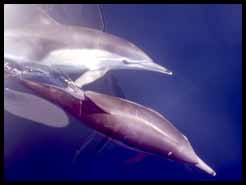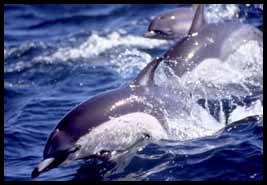Monterey Bay Whale Watch - Dec. 1997 Feature

 Common Dolphins in Monterey Bay
Common Dolphins in Monterey Bay

 |
 |
| Long-Beaked Common Dolphins |
Short-Beaked Common Dolphins |
Recent sea surface temperatures in Monterey Bay have been 2 to 5 degrees above
normal. This appears to be caused by anomalous warm water conditions that may
be a precursor to El Niño. According to recent oceanographic reports, true
El Niño conditions have not yet arrived in Monterey Bay; however, we are seeing
several species associated with warm water conditions. The most predominate
dolphins in the Bay over the last month include both Long-Beaked and
Short-Beaked Common Dolphins. Common Dolphins have recently been divided into
two species based on morphological features. These two species do not appear
to mix and occur in separate schools.
Common Dolphins are a spectacular sight as both species typically are found
in schools of 500 to over 2,000 individuals. Within these schools are
subgroups of mother/calf pairs, adult males, females without calves, and
juveniles. Calves are born year-round so we frequently see newborn calves
within these schools. These schools are easily sighted from a distance as
they are tightly grouped, causing considerable disturbance in the water, and
are often associated with large numbers of seabirds. The seabirds take
advantage of the dolphins' ability to herd fish toward the surface where the
birds then capture many fish escaping from the dolphins.
Since September, these dolphins have been sighted nearly every day in the Bay or surrounding
waters. The dolphins have been frequently associated with the edge of the
Monterey Submarine Canyon, an area that is known to concentrate prey. An
abundance of sardines and mackerel appears to be the primary prey of the
dolphins.
Both species of Common Dolphins are normally seen farther to the south, off
the Channel Islands and south to Baja California. In addition to common dolphins,
both Pilot Whales and False Killer Whales have been reported in the Bay over
the last month. Both of these species are also associated with warm water conditions
and are normally rare to the area. As true El Niño conditions are expected
to occur in the Bay in the coming months, we will be looking for and documenting
the presence of these and other unusual species.

|
|
|
 |
Features -- Dec. 1997 |
|
 |
|
| Monterey Bay Whale Watch, LLC |
84 Fisherman's Wharf
Monterey, CA 93940 |
|
| Phone 831-375-4658 |
|
| E-mail whaletrips@gowhales.com |
|
|
Copyright © 1999 Monterey Bay Whale Watch. All rights reserved.
Photos by Nancy Black and Richard Ternullo.
Last updated February 8, 1999


